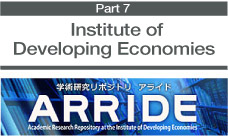Kanako Sakai
(Library, Institute of Developing Economies,
Japan External Trade Organization)

The Institute of Developing Economies, Japan External Trade Organization released ARRIDE (Academic Research Repository at the Institute of Developing Economies) as its institutional repository in August 2006. We are the first non-university research institute in Japan to do so. The development of an institutional repository as part of our electronic library had been under discussion since FY2003. One of the factors behind it was the need to enhance services for off-site users following the Institute’s relocation to Makuhari. It can also be said that making the Institute’s findings widely accessible free of charge is important in fulfiling our accountability obligations as a public research institute and also contributes to our mission to “make intellectual contributions to the world as a leading center of social science research on developing regions.”
A distinctive feature of ARRIDE is its specialization in topics in the social-science areas that constitute the Institute’s research field. In addition, given the large volume of research on developing countries and regions, another special feature is its “communities and collections” framework that can be searched by topic and by region, a feature shared with the shelving system of our library.
The results of an analysis of ARRIDE’s access log by Sato and Itsumura of University of Tsukuba indicate yet another distinguishing feature: ARRIDE receives more hits from abroad than the repositories of other Japanese institutes. This can be accounted for by the fact that metadata from ARRIDE are uploaded to RePEc (Research Papers in Economics), the international economics database, and access from abroad is via this route. So that metadata would not be uploaded to RePEc via OAI-PMH but rather would be processed in RDF format and uploaded that way, we developed our own program at the time of site construction and added it to DSpace. Their analysis can be said to provide objective support that this design works well. It is also relevant to our mission mentioned above, and as an administrator I have been delighted to realize that our institute is indeed “making intellectual contributions to the world” through ARRIDE. In addition, I have received an e-mail message from an author expressing their surprise and gratitude that his research outcome published as a discussion paper and not as journal article is being cited in the report of a international institute, which, they assume, is probably thanks to access through ARRIDE.
I have been joining the working group for institutional repository since FY2008. The position is held concurrently with other responsibilities: at first I was in charge of information services including editing and publishing the in-house newsletter. At the end of that fiscal year, however, the staff member who had been involved in the project since the construction stage resigned, and thereafter I also had to exercise jurisdiction over systems-related matters. Despite feelings of inadequacy resulting from my lack of server- and program-related expertise, with the help of my colleagues and others I have somehow managed to get by thus far.
Our Institute has another digital archive, AIDE, the Archive of IDE Publications. Most of the publications in this archive are sold, so we offer a service to members whereby they can view the publications for a fee for a set period of time after their publication and after that certain embargo period has ended the publications are shifted to open access. Because there is some duplication of functions, however, discontinuing ARRIDE and consolidating it with AIDE have been discussed as a cost-saving measure. But when the achievements mentioned earlier and the links to various external services that put the strengths of OAI-PMH to good use were taken into consideration, ARRIDE is still operating. Although there are still problems that must be solved such as the duplication of functions, the coexistence of fee-charging publications and open access, and integration of the search systems, ARRIDE’s accomplishments can be said to have won certain acclaim.
As for discussing “our institutional repository,” the period of my tenure is still quite brief, and the planning stage was before my time, but opportunities to write about ARRIDE, including this one, always make me admire the skill of its design at the time of construction, especially as far as the operating policy and the linkage to RePEc are concerned.
It depends on the field, but young researchers in particular attach great importance to electronic journals and tend not to come to the library. In such an environment, communications between librarians and researchers undeniably decline. However, the ones with high interest in the dissemination of information through the Internet are these researchers, and their great need for the repository’s dissemination function are keenly felt in the contents-collection process. Managing an institutional repository is an new opportunity for communication with researchers, but it can also be said to be a good opportunity to obtain information that may be useful in running the library, such as the various needs related to their research activities, their expectations of the library, etc. Despite many problems, such as understaffing and difficulties in growing the collection, I feel that running an institutional repository is an attractive job with important repercussions. In future I hope to continue to develop ARRIDE even further.
|

